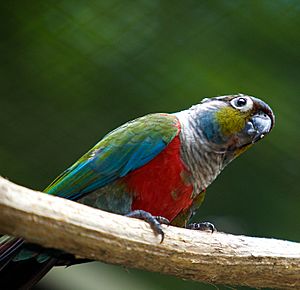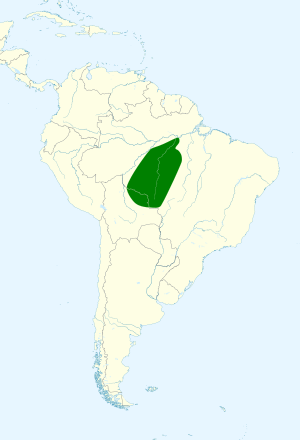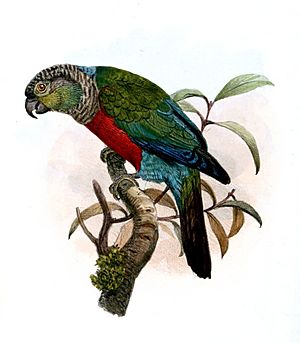Crimson-bellied parakeet facts for kids
Quick facts for kids Crimson-bellied conure |
|
|---|---|
 |
|
| Conservation status | |
| Scientific classification | |
 |
|
| Synonyms | |
|
Pyrrhura rhodogaster |

The crimson-bellied parakeet (Pyrrhura perlata) is a colorful bird found in the Amazon Basin of South America. It's also known as the crimson-bellied conure by bird enthusiasts. This parakeet belongs to the parrot family and is known for its bright red belly. It lives in the forests of Bolivia and Brazil.
Contents
Understanding the Crimson-bellied Parakeet's Name
How Scientists Name Animals
Scientists use a system called taxonomy to give living things unique names. This helps everyone know exactly which animal they are talking about. The crimson-bellied parakeet's scientific name is Pyrrhura perlata.
A Confusing Name Change
For a long time, this parakeet was called Pyrrhura rhodogaster. But in 1983, scientists discovered something interesting. A very old sample, which was thought to be a different bird, was actually a young crimson-bellied parakeet! Because this older sample had the name P. perlata, the rules of naming mean that Pyrrhura perlata became the correct scientific name for this bird. The old name, P. rhodogaster, is now a "junior synonym," meaning it's an older, less correct name.
One of a Kind
The crimson-bellied parakeet is considered "monotypic." This means there are no different subspecies or types of this specific parakeet. It's just one unique kind!
What Does the Crimson-bellied Parakeet Look Like?
This parakeet is about 24 to 25 centimeters (9.4 to 9.8 inches) long. It weighs between 76 and 91 grams (2.7 to 3.2 ounces). Male and female parakeets look very similar.
Colors and Markings
- Head: Their head is dark grayish-brown with light gray spots. They have dark brownish-gray ear feathers. Their upper cheeks are a golden-green, and their lower cheeks are turquoise-blue. A thin blue band crosses the back of their neck.
- Body: Their upper body is green with a hint of blue. Their throat and upper chest are gray to blue, looking a bit scaly. Sometimes, these feathers have pink tips.
- Belly: The most striking feature is their bright red belly and upper sides. Their lower sides and vent area are greenish-blue.
- Wings and Tail: Their wings are mostly green. The main flight feathers are black and cobalt blue. The feathers under their wings are red. Their tail is reddish-brown on top and blackish-brown underneath.
Other Features
Their eyes are dark brown. Their beak is blackish, and their legs are grayish-black. Young parakeets look much like adults, but their belly is mostly green instead of bright red.
Where Do Crimson-bellied Parakeets Live?
Their Home Range
The crimson-bellied parakeet lives in the Amazon Basin. You can find them in northeastern Bolivia. They also live in Brazil, south of the Amazon River. This includes parts of the states of Mato Grosso, Rondônia, Amazonas, and Pará.
Preferred Habitat
These parakeets mostly live in the tops of trees and at the edges of humid forests. These are often "terra firme" forests, which means they are on higher ground and don't flood. They also live in secondary forest, which is forest that has grown back after being cut down. Sometimes, they can be found in drier lowland forests too. They live at elevations up to about 600 meters (2,000 feet) high.
How Crimson-bellied Parakeets Live
Do They Move Around?
The crimson-bellied parakeet does not migrate. This means they stay in the same general area all year long.
What Do They Eat?
These parakeets mainly eat fruit. They also enjoy eating flowers as part of their diet.
How Do They Raise Their Young?
Crimson-bellied parakeets usually breed between August and November. They might also breed from April to June. Like other parakeets in their group, they likely build their nests inside holes in trees. A female parakeet usually lays four to six eggs. The eggs hatch after about 25 days. The young birds are ready to fly about seven to eight weeks after they hatch.
What Do Their Calls Sound Like?
The crimson-bellied parakeet makes a high, fast call that sounds like "wrr'wur-wir-wir-wir." They also make a unique sound. It's a bit like a toy trumpet, sounding like "peeéh."
Protecting the Crimson-bellied Parakeet
Conservation Status
The IUCN (International Union for Conservation of Nature) keeps track of how many animals are left in the wild. They currently list the crimson-bellied parakeet as "Least Concern." This means they are not in immediate danger of disappearing. However, their population is believed to be decreasing.
Threats to Their Survival
The biggest threat to these parakeets is deforestation. This is when large areas of forest are cut down. Land is cleared mainly for cattle ranching and to grow soy crops. This means the parakeets lose their homes. They are also sometimes affected by hunting.
Protected Areas
Even though their total range is very large (about 1,430,000 square kilometers or 552,000 square miles), about 75,000 square kilometers (29,000 square miles) of their habitat are in protected areas. These protected lands help keep their homes safe.
See also
 In Spanish: Perico perla para niños
In Spanish: Perico perla para niños




